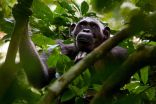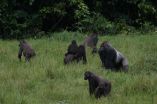A new report--titled "Regional Action Plan for the Conservation of Western Lowland Gorillas and Central Chimpanzees 2015-2025"--outlines the growing number of threats to these great apes across six range countries, including the finding that nearly 80 percent of great apes in the region occur outside of protected areas.
While national and international laws protect the Critically Endangered western lowland gorilla and the Endangered central chimpanzee, both subspecies continue to be threatened by hunters and traders seeking to supply the illegal commercial market and demand for bushmeat, particularly in urban areas.
Habitat loss driven by the region's growing human population and the expansion of extractive industries and industrial agriculture is another danger to great apes. And between the 1990s and 2005, Ebola outbreaks in northeastern Gabon and western Congo are thought to have killed thousands of gorillas and chimpanzees.
"The rainforests of Western Equatorial Africa contain most of the world's gorillas and about one-third of all chimpanzees, and gorillas in particular are being severely and negatively impacted by human activities across their range," said Dr. Fiona Maisels, WCS Conservation Biologist and a contributor to the plan. "This action plan represents a multi-dimensional conservation strategy to address the myriad of threats to our closest relatives."
Many of the actions proposed in the previous action plan published in 2005 were successfully implemented and have helped to slow the declines in the ape populations. However, the growing human population in the region coupled with the expansion of extractive industries and industrial agriculture are putting increasing pressure on the remaining great apes - so additional conservation measures are urgently required.
Building on the previous action plan, the new strategy is the product of a regional workshop attended by 70 conservationists, scientists, wildlife health experts, donors, and wildlife authorities and protected area managers from Angola, Cameroon, Central African Republic, Equatorial Guinea, Gabon, and the Republic of Congo. Survey data collected between 2003 and 2013 were used to produce great ape population density maps across the entire range of both western lowland gorillas and central chimpanzees to re-assess conservation priorities.
"Central African governments have demonstrated increased willingness to protect the dwindling populations of gorillas and chimpanzees," said David Greer, WWF's Great Apes Programme Manager. "Now bold steps are needed to ensure that existing wildlife laws are upheld and that weak governance, which results in widespread impunity for wildlife traffickers, is eliminated, to give great apes the opportunity to survive and thrive."
In the new plan, 18 landscapes are identified as critical for the continued survival of western lowland gorillas and central chimpanzees. These landscapes cover half the geographic range of these two subspecies, yet they harbor more than three quarters of the great apes remaining in the region.
Actions needed to protect the remaining gorilla and chimpanzee populations, and evaluate conservation success, include:
More effective management and protection of large areas outside of formally protected areas; Increased law enforcement combined with improved legal frameworks and stiffer sanctions for poachers; Coordination across all sectors on land use and protection of natural resources with a priority on conserving great ape populations; Conservation advocacy for wildlife and law enforcement to effect behavior change; An enhanced understanding of diseases such as Ebola to guide conservation actions; Monitoring of great ape abundance and distribution, habitat loss, and illegal activities.
"The action plan will serve as a guide for range-state governments and their conservation partners in how best to protect the region's natural heritage," said Dr. Liz Williamson, Vice Chair of the Great Ape Section of the IUCN SSC Primate Specialist Group. "Decisions made today can ensure a brighter future for gorillas and chimpanzees, and the human communities that rely on biodiversity for their well-being."
INFORMATION:
To access the document in English, click here:
http://www.primate-sg.org/storage/pdf/WEA_apes_plan_2014_7MB.pdf
For the same document in French, click here:
http://www.primate-sg.org/storage/pdf/WEA_Plan_grands_singes_4MB.pdf
The process of developing this conservation strategy was funded by the Arcus Foundation, the United States Fish and Wildlife Service, and the Great Apes Survival Partnership.
The following organisations contributed to development of the action plan: African Parks, African Wildlife Foundation, Agence Congolaise de la Faune et des Aires Protégées, Agence Nationale des Parcs Nationaux, Arcus Foundation, Bristol Conservation and Science Foundation, Conservation International, Convention on the Conservation of Migratory Species of Wild Animals, European Union, Fondation Camerounaise de la Terre Vivante, Goualougo Triangle Ape Project, Great Apes Survival Partnership, Instituto Nacional de Desarrollo Forestal y Manejo del Sistema de Áreas Protegidas, International Union for Conservation of Nature, Jane Goodall Institute, Living Earth Foundation, Max Planck Institute for Evolutionary Anthropology, Mayombe Transboundary Initiative, Ministère de l'Economie Forestière, de l'Environnement et du Tourisme, Ministère de la Forêt, de l'Environnement et de la Protection des Ressources Naturelles, Ministère des Forêts et de la Faune, Ministério do Ambiente, Projet d'Appui à l'Application de la Loi sur la Faune Sauvage, Projet Ecofaune, Projet Grands Singes, Réseau des Aires Protégées d'Afrique Centrale, United Nations Development Programme, United States Agency for International Development/Central African Regional Program for the Environment, United States Fish & Wildlife Service, University of Barcelona, Wildlife Conservation Society, WWF, Zoological Society of London.
About the Wildlife Conservation Society (WCS)
MISSION: WCS saves wildlife and wild places worldwide through science, conservation action, education, and inspiring people to value nature. VISION: WCS envisions a world where wildlife thrives in healthy lands and seas, valued by societies that embrace and benefit from the diversity and integrity of life on earth. To achieve our mission, WCS, based at the Bronx Zoo, harnesses the power of its Global Conservation Program in more than 60 nations and in all the world's oceans and its five wildlife parks in New York City, visited by 4 million people annually. WCS combines its expertise in the field, zoos, and aquarium to achieve its conservation mission. Visit: http://www.wcs.org;http://www.facebook.com/TheWCS; http://www.youtube.com/user/WCSMedia Follow: @thewcs.
About WWF
WWF is one of the world's largest and most respected independent conservation organizations, with more than 5 million supporters and a global network active in over 100 countries. WWF's mission is to stop the degradation of the earth's natural environment and to build a future in which humans live in harmony with nature, by conserving the world's biological diversity, ensuring that the use of renewable natural resources is sustainable, and promoting the reduction of pollution and wasteful consumption.
http://www.panda.org/media for latest news and media resources.
About IUCN
IUCN, International Union for Conservation of Nature, helps the world find pragmatic solutions to our most pressing environment and development challenges. IUCN's work focuses on valuing and conserving nature, ensuring effective and equitable governance of its use, and deploying nature-based solutions to global challenges in climate, food and development. IUCN supports scientific research, manages field projects all over the world, and brings governments, NGOs, the UN and companies together to develop policy, laws and best practice. IUCN is the world's oldest and largest global environmental organization, with more than 1,200 government and NGO members and almost 11,000 volunteer experts in some 160 countries. IUCN's work is supported by over 1,000 staff in 45 offices and hundreds of partners in public, NGO and private sectors around the world.
Web: http://iucn.org



